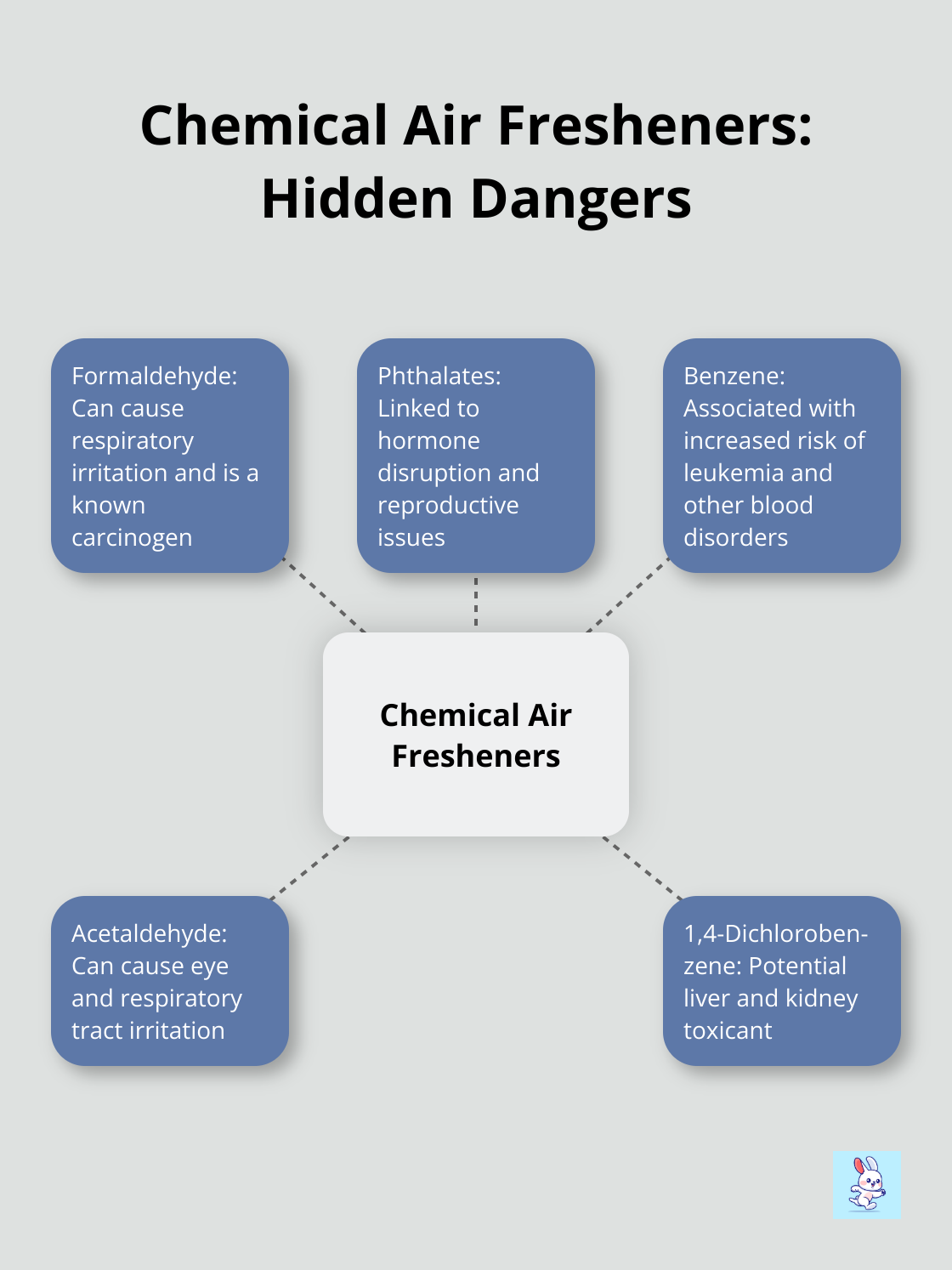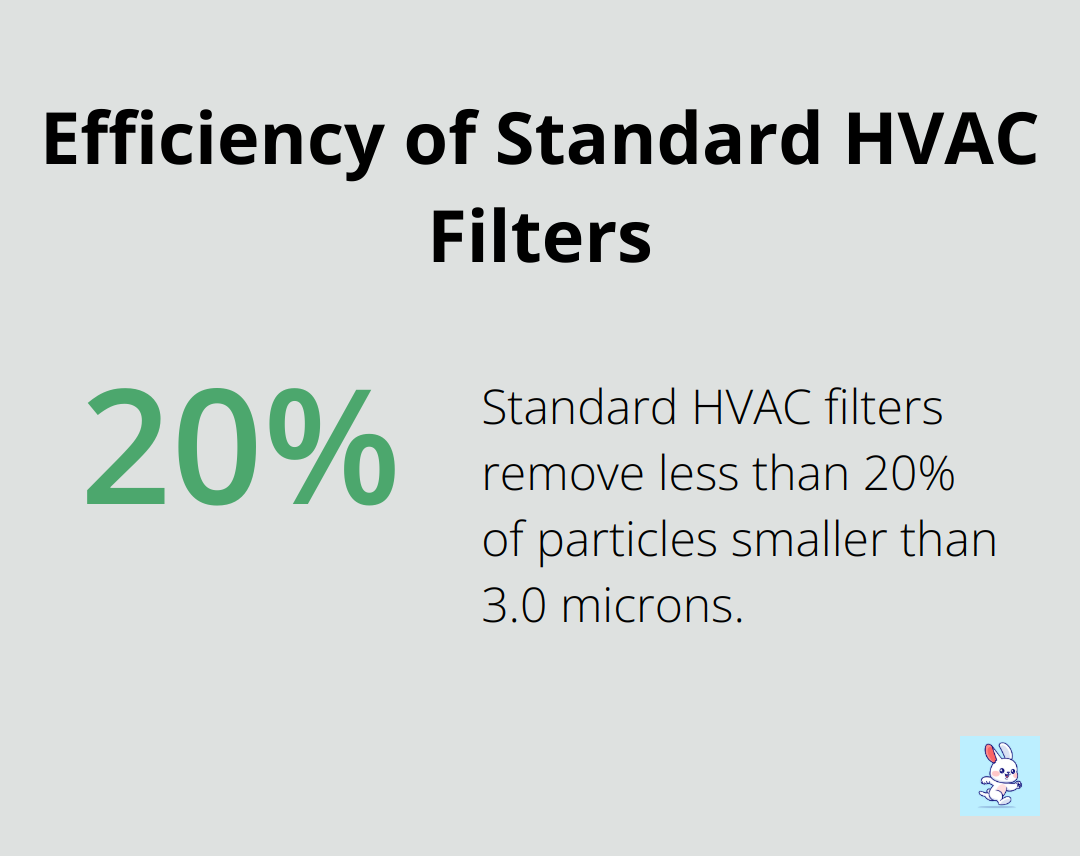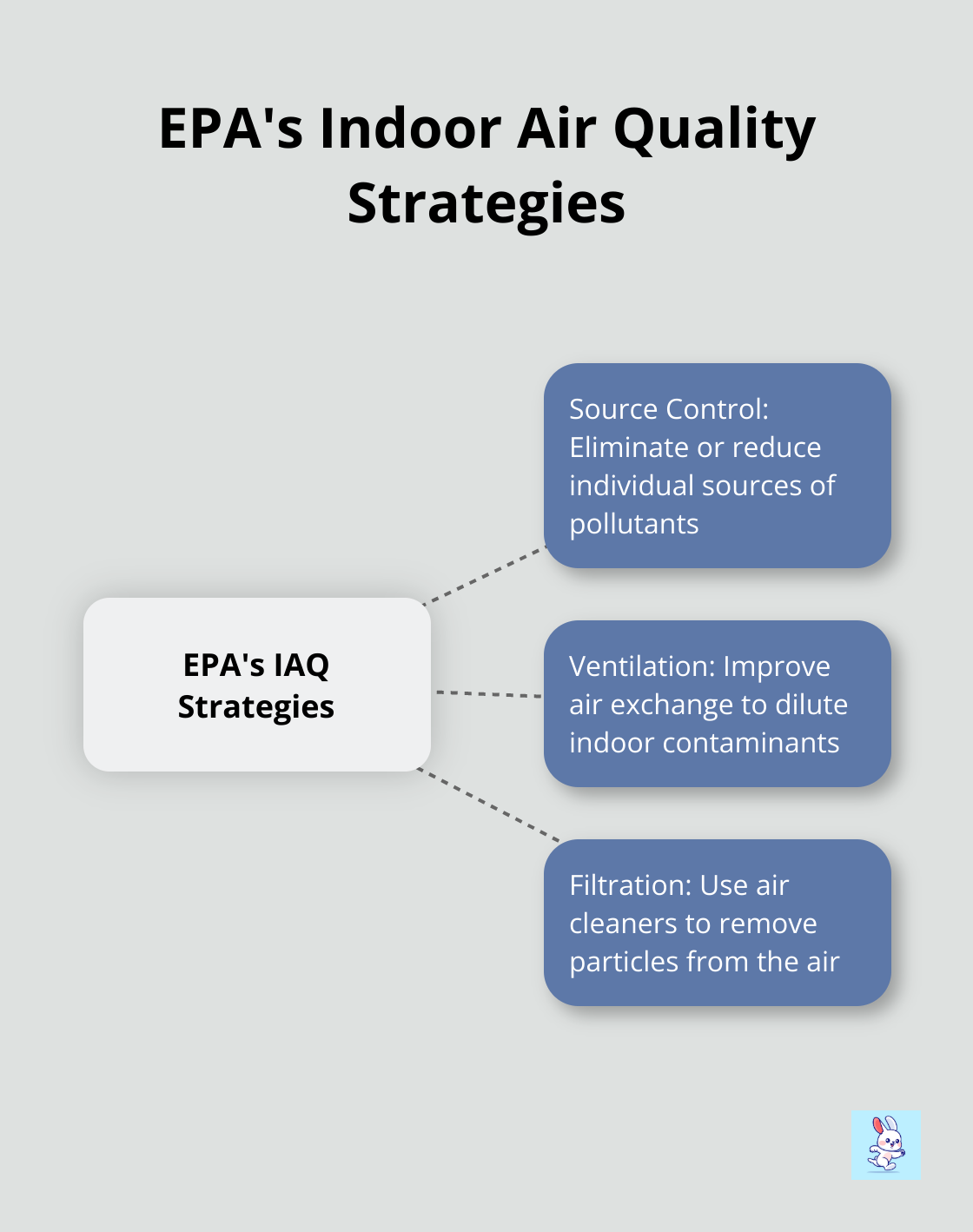Indoor air myths can significantly impact our health and well-being. Many people unknowingly follow practices that may worsen their indoor air quality.
At Cleaning Rabbit, we’ve seen firsthand how these misconceptions affect homes and businesses. In this 2025 update, we’ll debunk three common myths about indoor air quality and provide practical solutions for cleaner, healthier indoor environments.
Do Air Fresheners Really Clean Your Air?
The Truth About Chemical Air Fresheners
Many people believe air fresheners improve indoor air quality. This misconception can lead to more harm than good. Chemical air fresheners often contain volatile organic compounds (VOCs) that irritate eyes, nose, and throat. A survey of selected scented consumer goods showed the products emitted more than 100 VOCs, including some that are classified as toxic or hazardous. These products don’t remove pollutants; they simply add more chemicals to your indoor environment.

Health Risks of Synthetic Fragrances
Synthetic fragrances in air fresheners can trigger allergic reactions, headaches, and asthma attacks. The American Academy of Allergy, Asthma & Immunology warns that these artificial scents may worsen symptoms for people with fragrance sensitivities. Long-term exposure to certain air freshener chemicals has even been associated with an increased risk of respiratory problems.
Natural Alternatives for Fresher Indoor Air
Instead of relying on chemical air fresheners, try these natural alternatives:
- Open windows regularly to allow fresh air circulation.
- Use baking soda to absorb odors naturally.
- Simmer cinnamon sticks, cloves, and citrus peels for a natural fragrance.
- Maintain indoor plants like peace lilies or spider plants to help purify air.
- Use essential oil diffusers with pure, high-quality oils.
The Importance of Addressing Root Causes
Truly fresh air comes from addressing the root causes of odors and pollutants. Regular cleaning, proper ventilation, and professional air duct cleaning services are far more effective in improving your indoor air quality than any air freshener could be.
As we move on to our next myth, it’s important to understand that while air fresheners might mask odors, they don’t address the underlying issues affecting your indoor air quality. Let’s examine another common misconception: the belief that HVAC filters alone are sufficient for maintaining clean air in your home or office.
Are HVAC Filters Enough for Clean Air?
The Limitations of Standard HVAC Filters
Many homeowners believe that regular HVAC filter changes suffice for clean indoor air. This misconception overlooks several critical factors in achieving optimal air quality. Most residential HVAC filters have a MERV (Minimum Efficiency Reporting Value) rating between 1 and 4, which only removes particles larger than 3.0 – 10.0 microns with less than 20% efficiency. This leaves many allergens, bacteria, and volatile organic compounds (VOCs) circulating in your home.

The Importance of Duct Cleaning
Even with regular filter changes, your HVAC system’s ductwork can accumulate dust, mold, and other contaminants over time. The National Air Duct Cleaners Association (NADCA) emphasizes the importance of proper duct maintenance guided by ACR, The NADCA Standard, for contributing to a healthier indoor environment. Neglected ducts can significantly impact air quality, especially in older homes or buildings with pets.
Comprehensive Air Purification Strategies
To truly improve your indoor air quality, implement a multi-faceted approach:
- Upgrade to high-efficiency filters: Choose MERV ratings of 11 or higher for better filtration of smaller particles.
- Install a whole-house air purifier: These systems work with your HVAC to remove a wider range of pollutants.
- Use portable air cleaners: Place HEPA air purifiers in frequently used rooms for additional filtration.
- Improve ventilation: Use exhaust fans and open windows (when weather permits) to ensure proper air exchange.
- Control humidity: Keep indoor humidity levels between 30-50% to discourage mold growth and dust mite proliferation.
The Role of Professional Assessments
Regular air quality assessments help identify specific pollutants in your home and guide targeted solutions. Professional services measure levels of particulate matter, VOCs, and other contaminants, allowing for a more precise approach to air quality improvement.
While HVAC filters play a vital role, they’re just one piece of the indoor air quality puzzle. A comprehensive approach (including regular duct cleaning and additional purification methods) ensures cleaner, healthier air in your home or office. But what about the air outside? Many people assume indoor air is inherently cleaner than outdoor air. Let’s examine this common misconception in our next section.
Is Indoor Air Really Cleaner Than Outdoor Air?
The Misconception of Indoor Air Safety
Many people believe that staying indoors protects them from air pollution, but this idea is often wrong. The Environmental Protection Agency (EPA) emphasizes the importance of source control, ventilation and filtration to reduce exposure to indoor pollutants and improve indoor air quality.

Hidden Pollutants in Our Homes
Our indoor environments contain numerous pollutants that we often ignore. These include:
- Volatile organic compounds (VOCs) from paints, cleaning products, and furniture
- Particulate matter from cooking and fireplaces
- Biological contaminants like mold spores and dust mites
A study by the Silent Spring Institute collected indoor air and dust samples from 120 homes on Cape Cod and measured the concentrations of 89 different compounds.
Modern Living and Air Quality
Modern building practices that focus on energy efficiency have unintentionally contributed to poor indoor air quality. Tightly sealed homes trap pollutants inside, which leads to a buildup of contaminants over time. The American Lung Association warns that this can worsen respiratory issues and allergies, especially in vulnerable populations (such as children and the elderly).
The Importance of Ventilation
Proper ventilation plays a key role in maintaining healthy indoor air. The American Society of Heating, Refrigerating and Air-Conditioning Engineers (ASHRAE) recommends a minimum of 0.35 air changes per hour for residential buildings. You can achieve this through a combination of natural ventilation (opening windows) and mechanical systems like exhaust fans and heat recovery ventilators.
Practical Steps for Cleaner Indoor Air
- Use exhaust fans in kitchens and bathrooms to remove pollutants at the source.
- Open windows for at least 15 minutes daily, even in winter, to allow fresh air circulation.
- Invest in a high-quality air purifier with HEPA filters to capture airborne particles.
- Choose low-VOC paints and furnishings to minimize chemical off-gassing.
- Clean and maintain HVAC systems regularly to prevent the spread of contaminants.
While outdoor air quality concerns are valid, especially in urban areas, it’s important not to neglect the air quality within our homes and workplaces. Understanding the sources of indoor pollution and taking proactive steps to improve ventilation and reduce contaminants will create healthier indoor environments.
Final Thoughts
Indoor air myths can significantly impact our health and well-being. We have exposed several misconceptions about air fresheners, HVAC filters, and the cleanliness of indoor versus outdoor air. Proactive air quality management proves essential for creating healthier living and working environments.
Understanding pollution sources and addressing them will improve the air we breathe daily. This includes regular cleaning, proper ventilation, air purifier use, and HVAC system maintenance. At Cleaning Rabbit, we help you achieve superior air quality in your home or business.
Our family-owned service specializes in air duct cleaning, dryer vent cleaning, HVAC sanitation, and air quality assessments (using advanced HEPA-filtered equipment). We treat your property with care and attention, ensuring a healthier environment for you and your loved ones.

![Debunking Common Indoor Air Quality Myths [2025 Edition]](https://cleaningrabbit.com/wp-content/uploads/emplibot/indoor-air-myths-1752365256-1024x585.jpeg)